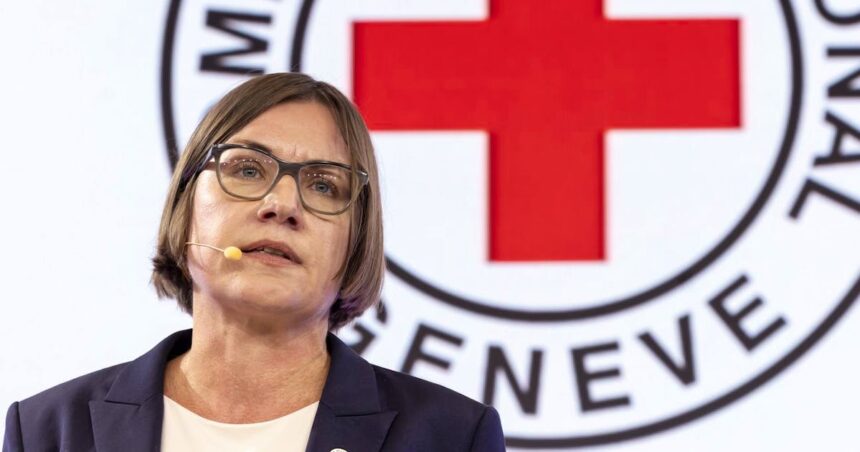The head of the International Committee of the Red Cross has issued what can only be described as a desperate plea for restraint in the Middle East. Standing before cameras in Geneva last week, Mirjana Spoljaric’s face betrayed the gravity of what humanitarian workers are witnessing on the ground.
“We risk entering into an uncontrollable crisis,” Spoljaric warned, her voice carrying the weight of an organization that has operated in war zones since 1863. “A regional conflict would be devastating for the entire region and have global implications.”
Having just returned from fieldwork along the Israel-Lebanon border, I’ve seen firsthand how the escalating cross-border exchanges between Israeli forces and Hezbollah fighters have transformed sleepy agricultural communities into ghost towns. In northern Israeli kibbutzim, only military personnel and a handful of stubborn residents remain. Across the border in southern Lebanon, entire villages sit empty as families flee northward toward Beirut.
What began as a contained conflict following Hamas’ October 7 attack has metastasized into what the ICRC president calls “a very dangerous moment” across multiple fronts. The humanitarian situation in Gaza remains catastrophic, with 75% of the population displaced and essential services destroyed.
“The laws of war are being eroded daily,” Spoljaric emphasized, noting that civilians are bearing the heaviest burden of the expanding conflict.
The numbers tell a devastating story. According to UN estimates, over 41,000 Palestinians have been killed or wounded in Gaza since October. Lebanon has reported over 200 deaths since Hezbollah began launching rockets into Israel in solidarity with Hamas. Meanwhile, Israeli authorities report that Hamas’ October attack killed approximately 1,200 people, with another 250 taken hostage.
The ICRC’s warning comes as diplomatic efforts appear increasingly ineffectual. Despite months of U.S.-led negotiations, ceasefires remain elusive. Qatar-based mediation efforts have repeatedly stalled, and regional players like Egypt and Turkey have been unable to leverage their influence into meaningful de-escalation.
During my recent interview with a former Israeli defense official who requested anonymity, they admitted, “We’re in uncharted territory now. The multi-front scenario we’ve always feared is becoming reality.”
The humanitarian consequences extend far beyond the immediate conflict zones. In southern Lebanon, municipal leader Hassan Qarouni told me how their community’s population has tripled in recent weeks. “We have families sleeping in school hallways, in parking garages, anywhere with a roof,” he explained. “Winter is coming, and we have no capacity to shelter everyone.”
The World Food Programme has documented alarming food insecurity across the region, with Gaza facing imminent famine conditions. In parts of southern Lebanon, displaced communities are reporting critical shortages of basic supplies as humanitarian access remains severely restricted by ongoing hostilities.
Perhaps most concerning is the ICRC’s assessment that humanitarian law is being systematically violated. The protection of civilians, medical facilities, and humanitarian workers—bedrock principles of international humanitarian law—appears increasingly ignored by all parties.
“The ICRC’s neutral intermediary role is being challenged like never before,” noted Marc Kilstein, a conflict resolution specialist at the Geneva Center for Security Policy. “When warring parties no longer respect humanitarian space, the entire system of international humanitarian response begins to collapse.”
Beyond the immediate casualties, the conflict threatens to unravel decades of development work. The World Bank estimates economic losses across Gaza will exceed $10 billion, while Lebanon—already struggling through an economic crisis—could see additional GDP contraction of 3-5% if hostilities continue.
The ICRC’s warning about regional escalation appears increasingly prophetic. Iranian-backed militias in Iraq and Syria have intensified attacks on U.S. forces in recent weeks. The Houthis in Yemen continue targeting commercial shipping in the Red Sea. Each incident raises the temperature of a region already at boiling point.
“What we’re witnessing is the failure of deterrence on all sides,” explained Dr. Sanam Vakil, Middle East program director at Chatham House. “When parties believe escalation serves their interests better than restraint, the guardrails come off.”
For ordinary civilians caught in the widening gyre, the ICRC’s warning translates to immediate existential concerns. In Tyre, Lebanon, I met Fatima, a mother of three who fled her village near the Israeli border. “We don’t know if we have homes to return to,” she said, cradling her youngest child. “Each day the bombs fall closer to where we’re sheltering now.”
The ICRC’s urgent appeal for restraint and humanitarian access represents perhaps the last circuit breaker before the crisis becomes truly uncontrollable. As Spoljaric emphasized, “This is a moment that requires leadership and courage from all sides to prevent further suffering.”
Whether that leadership materializes remains an open question. For now, humanitarian workers continue their dangerous work in increasingly impossible circumstances, trying to uphold principles of humanity in a region where those principles feel more endangered with each passing day.






